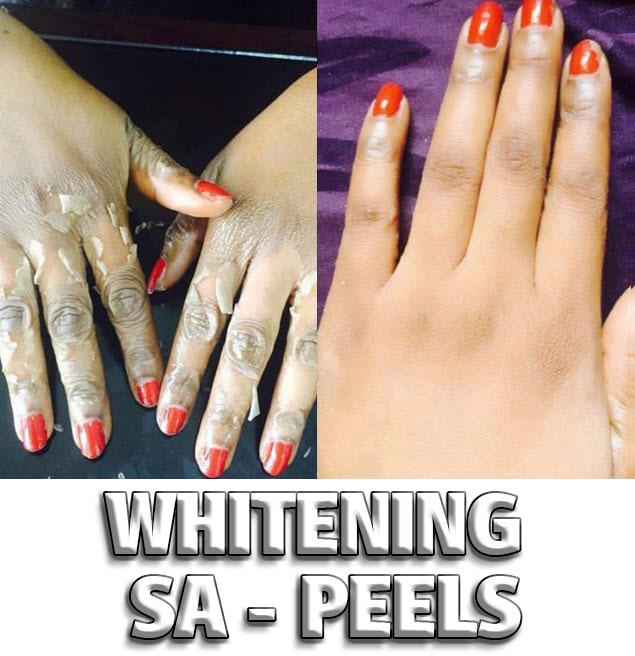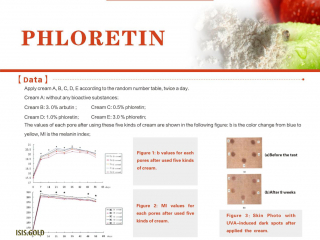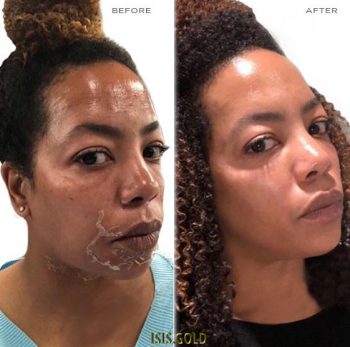WHITENING CHEM PEELS
These new chemical peel products peel your skin just like Saliclear with the added benefit of also whitening/bleaching your skin. I found a more useful way to apply these new whiteners by simply dissolving the powders along with Salicylic acid powder to make very strong bleaching/whitening peels. Some of them are herbal others contain the hardcore skin bleaching agents.
WHAT TO EXPECT
These products contain 30% Salicylic acid, therefore your skin will peel the same as it does with Saliclear. These products are basically Saliclear with whitening agents added.
INGREDIENTS EXPLAINED
Of course you already know bout Hydroquinone and Mequinol. These are the strongest most potent hardcore skin bleaching agents. The below skin whitening agents are completely herbal and will whiten skin several shades, some are just as strong as HQ.
Phloretin: This is a new skin whitening agent that has gained popularity over that last year. Phloretin is a dihydrochalcone compound and a type of natural phenol extracted from the peels of apples & the root and barks of apple trees. Phloretin inhibits melanocytes and disrupts tyrosinase activity causing the skin to whiten. Studies have shown that Phloretin is as strong as arbutin (hydroquinone precursor). Phloretin is a very potent anti-oxidant. It can remove free radicals from the skin, prevent cell mutation, accelerate cell metabolism, reduce wrinkles, and enhance the skin’s supporting structure and immunity to UV light.
Phloretin is also an anti-inflammatory. This may not be as important to some of you, but regarding skin bleaching, it should be. When our skin becomes red due to trauma (i.e. injury, sunburn, pimple, etc.) that redness later turns into hyper-pigmentation or a dark spot/mark/patch. Also, for FITZ I-III (natural or bleached) the skin is so light that you can now “see” everything, like spider veins & red patches of tiny blood vessels. Ingredients like Phloretin will work on shrinking healing and diminishing those inflamed blood vessels, hence removing redness. Having anti-inflammatory properties makes Phloretin very effective in whitening skin, and removing red patches (rosacea) especially seen in FITZ I and FITZ II (natural or bleached) Download Phloretin info sheet [Phloretin.pdf]
Phloretin is still fairly new so not many shoppes carry products containing this ingredient. Skinceuticals sells a product called Phloretin CF, it’s 2fl.oz, contains only 2% phloretin, and costs $166. My AppleWhite cream contains 20% phloretin, is deep penetrating, comes in 2fl.oz-8 fl.oz sizes, and cost a fraction of what Skinceauticals is charging. Checkout the reviews on their website, it’s extremely expensive but the results of phloretin are real. Even at just 0.5% phloretin whitens skin by 2 shades lighter. View the before & after photos from the study above.
High Dose Phloretin Will:
• Whiten Skin Many Shades
• Remove Dark Spots & Melasma Patches
• Remove Red Spots
• Smooth Skin & Diminish Wrinkles
• Diminishes Rosacea & Redness
Tetrhydrocurcumin: Hydroquinone is a Super-Antioxidant and is “Queen” when it comes to skin whitening/bleaching. HQ is the safest most potent synthetic skin whitening agent on the market. Unfortunately, HQ is banned in countries like India, Philippines, China, United Kingdom, Jamaica, and Africa. So darkskin people in those countries have had to find hydroquinone alternatives. Hydroquinone is one of many synthetic skin bleaching agents on the market, it just happens to be the most accessible and affordable skin bleaching option. There are also many herbal skin whitening agents & skin whitening peptides. These skin whitening herbal extracts & peptides are a very expensive option, but unfortunately they are the only option for for some people – because they are either allergic to HQ or HQ is banned in their country.
By now you’ve probably seen plenty of Youtube skincare videos about turmeric root and how it lightens skin, evens skintone, and removes dark spots. Even just a small amount of turmeric root powder in a face pack/mask or DIY cream significantly whitens skin and removes dark patches. I’m amazed at how turmeric root can remove darkspots/patches without targeting them directly with the eyeliner brush method. When applied ALL over, turmeric automatically targets those darkspots! In my research I found out the turmeric root is a old herb, used for thousands of years by indigenous Indian people. Not just as a culinary spice, but as a skin beautifying herb. Search the internet and you’ll find hundreds of articles and tutorial videos of Indian women sharing these skin whitening secrets.
I got to digging, I had to find out “What is this potent herbal whitening active contained in the turmeric root???”. Well, I found it and the chemical is called Tetrahydrocurcumin (THC). THC is a colorless hydrogenated product exctracted directly from the orange-yellow curcuminoids of the turmeric root. THC inhibits tyrosinase, which prevents the skin from producing melanin at all. THC is just as effective as hydroquinone, and at even lower doses. THC 0.25% is as strong as 4% Hydroquinone. THC functions as an excellent antioxidant used for skin whitening; has superior antioxidant and anti-inflammatory properties; and provides UVB skin protection. THC powder is pure white, unlike the brilliant orange-yellow color of ordinary herbal turmeric powder. The only downside of using raw turmeric powder is the herb stains everything yellow – skin, clothes, floors, rugs, everything!
Read below for more information about these active ingredients. [Source: Sabinsa]
Video Results: Turmeric Root Powder
Niacinamide: Is a form of Vitamin-B3 (an amide) called nicotinamide (also known as niacinamide). Nicotinamide is an essential water-soluble vitamin, which is not synthesized in the body, meaning we have to eat it or apply it topically to receive its benefits. This single skincare ingredient could treat virtually ALL of your skin concerns. Niacinamide reduces melanin production from 35%-68% within 4 weeks!
Benefits:
• Removes Hyperpigmentation
• Smooths Wrinkles
• Treats Acne
• Treats Oily Skin
• Diminishes Large Pores
• Treats Dry Skin
• Removes Redness & Inflammation
and more!
N-Acetyl Glucosamine: NAG is considered to be a “skin identical ingredient”, meaning it’s found in our skin in the spaces between the cells, and it is used to maintain skin’s barrier abilities and reduce dryness. Studies have shown that NAG can increase collagen production, increase moisture content of the skin, increase elasticity of the skin, increase exfoliation, and increase the speed of wound healing. NAG has been shown to reduce hyperpigmentation and can be combined with niacinamide to further increase its ability to reduce hyperpigmentation. N-Acetyl Glucosamine is an amino sugar that has skin exfoliating properties similar to alpha and beta hydroxyl acids without the irritation. NAG can normalize the exfoliation of the stratum corneum, so it can be a good replacement for acid based exfoliation ingredients that might annoy sensitive or rosacea prone skin. NAG raises glutathione levels by 38%
Benefits:
• Increases hyaluronic acid production in the skin
• Repairs and treat sun damage
• Reduces the appearance of wrinkles
• Accelerates wound healing
• Reduces trans-epidermal water loss
• Improves skin tone
• Improves barrier function
• Reduces hyperpigmentation
• Improves skin hydration
N-acetyl cysteine: NAC is a precursor to L-Cysteine, which the body needs to synthesize Glutathione. NAC whitens skin by raising Glutathione levels in the body (up to 600%!). What’s more, it boasts powerful antioxidant properties that help prevent premature aging of skin cells—resulting to a lighter, brighter, and younger-looking complexion. NAC works in synergy with Nicinamide and NAG to whiten skin and remove wrinkles.
Benefits:
• Raises Glutathione Levels
• Anti-Ageing
• Antioxidant
• Fights cell-damaging free radicals
Ferulic Acid: I have added this ingredient as an anti-oxidant stabilizer & intensifier; preservative; and skin beautification. Ferulic acid is a powerful antioxidant naturally found in the cell wall of plants including bran and certain fruit seeds where it helps to protect and preserve. In skincare, it does the same: protects & preserves. Applied topically, ferulic acid can protect against free radicals and help with skin rejuvenation. Ferulic Acid diminishes fine lines and wrinkles; strengthens and firms skin. Ferulic acid works in synergy with other potent antioxidants. It not only stabilizes highly oxidative vitamin-C, it actually intensifies the efficacy of vitamin-C and other skin whitening antioxidants. According to the Journal of Investigative Dermatology, “Ferulic acid alone provides partial protection but vitamins C, E and ferulic acid [all together] provide virtually complete protection.”
[Recommended Max: 1%]
Pterostilbene: Pterostilbene (trans-3,5-dimethoxy-4-hydroxystilbene) is a natural dietary compound and the primary antioxidant component of blueberries. Pterostilbene is a more potent form of resveratrol, it is four times easier to absorb into the skin than resveratrol because the molecules are much smaller. This makes Pterostilbene much more effective than regular ole’ resveratrol. At only 0.4% Pterostilbene whitens skins and removes darkspots. Pterostilbene is also a mild UV sunscreen just like resveratrol.
[Recommended Max: 0.5%]
Aloin (or Aloein): It’s been proven through scientific studies that chemicals present in Aloe Vera pulp have skin whitening properties. The chemicals are Aloesin and Aloin. Which are also anthraquinones (quinones bleach skin). These chemicals eliminate darkspots & hyperpigmentation by destroying excess melanin and also keeping the skin from producing excess melanin in the future. To be specific, Aloin focuses on destroying the melanin in pigmented skin cells (darkspots/redspots/melasma) while the Aloesin keeps the skin from producing additional melanin. This combined effect significantly reduces hyperpigmentation & whitens skin.
Licorice (Glycyrrhiza): The Glycyrrhiza glabra plant contains several different phytocompounds: Glabridin, glycyrrhizin (dipotassium glycyrrhizinate), glycyrrhetinic acid, and isoflavones. When extracted all are a bright white powder, unlike licorice root extract which is a dark brown liquid or powder. All are skin whitening agents, with Glabridin being the most potent (16 times stronger than HQ) and glycyrrhizin being second strongest (about 6 times stronger). Glabridin, is a very potent tyrosinase inhibitor. Liquiritin, is also a tyrosinase inhibitor but more of a co-whitener to Glabridin and Glycyrrhizin. Glabridin is very expensive ($30/gram!) and wouldn’t be cost effective for making a 20% cream. This serum contains Glycyrrhizin 20%, not as expensive ($200-$300/kg) as glabridin, the second strongest licorice extract, but is still more potent than hydroquinone.
About Licorice Extract:
Licorice extract is extracted from the roots of the Glycyrrhiza glabra plant. This plant belongs to the Fabaceae family and has been recognized since ancient times for its ethnopharmacological values. Glycyrrhiza glabra is one of the most popular medicinal plants belonging to the Fabaceae family (also known as Leguminosae) and is commonly used as feed and food. The genus Glycyrrhiza is derived from the Greek words glykos (sweet) and rhiza (root). Most licorice root grows in Greece, Turkey, and Asia. Licorice root extract is commonly used to flavor licorice candy, and is also used as a sweetener in hot beverages & in cooking/baking. For centuries licorice root has been used in Greece, China, and Egypt for stomach inflammation and upper respiratory problems. Some people use licorice root as a dietary supplement for digestive problems, menopausal symptoms, cough, and bacterial and viral infections. People also use licorice root as a shampoo. Licorice root powder is brown, because it is just the raw root ground up into powder. The chemical within licorice root plant, glabridin/glycyrrhizin/liquirin, are not brown. When extracted, glabridin/glycyrrhizin/liquirin is a pure bright white powder with a very strong licorice smell & taste.
Vitamin-C (ascorbic acid): L-Ascorbic acid (vitamin-C) is a potent antioxidant chemical that is used topically in dermatology to treat and prevent photo-ageing & hyper-pigmentation. Vitamin-C evens skin tone; smooths rough textured skin; removes fine lines & wrinkles; removes acne scars. With continued topical & oral use, vitamin-C can help prevent dark spots from forming in the first place. Because vitamin-C is unstable and difficult to absorb into the dermis in the optimum dosage, stable liposomal compounds of Vitamin-C have been created to enhance the delivery of Vitamin C into the dermis. Vitamin-C is essential for collagen & elastin biosynthesis, and it is also an anti-inflammatory. There are whitening agents that interrupt key steps of melanogenesis (melanin production), Vitamin-C is one of those particular depigmenting agents. Tyrosinase converts the amino acid tyrosine into eumelanin/pheomelanin, the pigments that gives your skin its color. Vitamin-C whitens skin by interacting with copper ions at the tyrosinase-active site and inhibits action of the enzyme tyrosinase, thereby decreasing melanin formation. Vitamin-C also acts on perifollicular pigment. Oral vitamin-C alone diminishes the hyperpigmentation around your hair pores, and the dark bumps that result from Keratosis Pilaris. Your body requires vitamin C in all stages of wound healing. Applying vitamin-C to a healing wound will speed up healing and reduce scarring. Because vitamin-C is highly acidic, when it is used topically the skin is triggered to heal itself by accelerating the production of collagen and elastin. Collagen and elastin are both naturally occurring protein fibers that help keep skin plump and firm. This is also how vitamin-C is able to prevent premature ageing.
Vitamin-C Explained:
Hesperidin: Also known as lemon peel extract or orange peel extract, Hesperidin is a bioflavonoid with high concentration in citrus fruits (more specifically in the actual peels of lemons & oranges). In addition to its well-known benefits for cardiovascular function (spider/varicose veins treatments), type II diabetes, and anti-inflammation, recent studies have demonstrated multiple benefits of hesperidin for cutaneous functions. Including wound healing, UV protection, anti-inflammation, antimicrobial, anti-skin cancer, and skin lightening. In addition, hesperidin enhances epidermal permeability barrier homeostasis in both normal young & aged skin. The mechanisms by which hesperidin benefits cutaneous functions are attributable to its antioxidant properties, inhibition of MAPK-dependent signaling pathways, and stimulation of epidermal proliferation, and lipid production. Hesperidin can be taken as an oral supplement also. [Source #1, Source #2, Source #3, Source #4]
Benefits:
• Whitens Skin & Evens Skintone
• Diminishes Spider & Varicose Veins
• Remove Darkspots & Age Spots
• Diminishes Wrinkles
• Removes Redness
• Soothes Skin
• Alleviate Dry Skin
• Diminishes Acne Scaring
• Removes Red Spots (especially in FITZ I skin)
[Recommended Max: 3%]










1 review for WHITENING SA PEELS